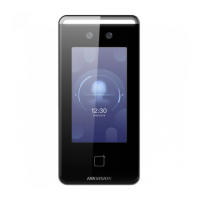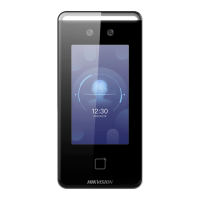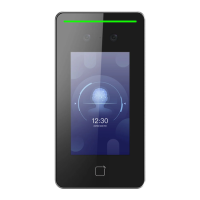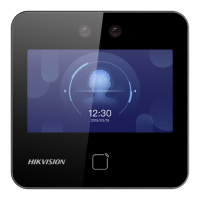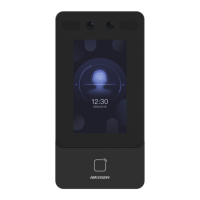
Do you have a question about the HIKVISION DS-K1T341CMF and is the answer not in the manual?
| Type | Face recognition terminal |
|---|---|
| Product color | Black, Silver |
| Cards capacity | 3000 cards |
| Event capacity | 150000 |
| Access code reader | - |
| Authentication type | Access chip/card, Face recognition |
| Face recognition distance | 0 - 2 m |
| Face recognition duration | 0.2 s |
| Access chip/card reader type | Contact |
| International Protection (IP) code | IP65 |
| Operating system installed | Linux |
| Screen shape | Flat |
| Display diagonal | 4.3 \ |
| Maximum resolution | 272 x 480 pixels |
| Touchscreen technology | Capacitive |
| Total megapixels | 2 MP |
| Ethernet LAN data rates | 10, 100 Mbit/s |
| Power consumption (typical) | 10 W |
| Operating temperature (T-T) | -30 - 60 °C |
Highlights critical warnings that could result in death or serious injury if neglected.
Lists precautions to prevent potential injury or material damage.
Details the key features, specifications, and capabilities of the device.
Guidelines for selecting an optimal installation environment to ensure proper functionality.
Step-by-step instructions for installing the device using a standard gang box.
Steps to activate the device directly through its interface.
Instructions for activating the device using a web browser interface.
Guide on using the SADP tool for device activation and IP address modification.
Steps to activate the device using the client software.
Guides on configuring network settings, including wired and Wi-Fi connections.
Instructions for adding an administrator to manage device parameters.
Covers logging in by administrator, activation password, and password recovery.
Configuration for wired, Wi-Fi, RS-485, Wiegand, ISUP, and platform access.
Includes adding administrators, face, fingerprint, card, PIN, and managing user settings.
Explains single and multiple credential authentication methods.
Provides a flow diagram illustrating the client software configuration process.
Covers adding devices by IP/domain, segment, EHome, batch import, and password reset.
Managing persons via organizations, basic info, cards, fingerprints, photos, and custom fields.
Creating access groups and assigning them to persons and access points.
Configuring advanced features like custom Wiegand, anti-passback, and multi-factor authentication.
Setting up client and device actions triggered by access control events.



